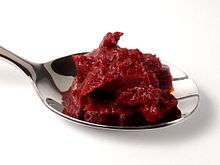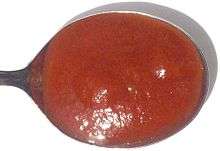Tomato paste


Tomato paste is a thick paste that is made by cooking tomatoes for several hours to reduce moisture, straining them to remove the seeds and skin, and cooking them again to reduce them to a thick, rich concentrate.[1]
In contrast, tomato purée is a liquid with a consistency between crushed tomatoes and tomato paste, and consists of tomatoes that have been boiled briefly and strained.[2]
Tomato paste was traditionally made in parts of Sicily, southern Italy and Malta by spreading out a much-reduced tomato sauce on wooden boards.[3] The boards are set outdoors under the hot August sun to dry the paste until it is thick enough, when scraped up, to hold together in a richly colored, dark ball. Today, this artisan product is harder to find than the industrial (much thinner) version.[4] Commercial production uses tomatoes with thick pericarp walls and lower overall moisture,[5] these are very different from the tomatoes typically found in a supermarket.
Tomato paste became commercially available in the early 20th Century.
In the UK, paste is referred to as purée or concentrate.
In the US, tomato paste is concentrated tomato solids (no seeds or skin), sometimes with added high fructose corn syrup, and with a standard of identity (see 21 CFR 155.191).[6] Tomato purée has a lower solids requirement.
Depending on its manufacturing conditions, tomato paste can be the basis for making ketchup or reconstituted tomato juice.
- Hot break: heated to about 100 °C; pectin is preserved -> thicker -> ketchup
- Warm break: heated to about 79 °C; colour is not preserved, but flavour is
- Cold break: heated to about 66 °C; colour and flavour is preserved -> juice
See also
References
- ↑ Kimberley Willis, Viktor Budnik Knack Canning, Pickling & Preserving: Tools, Techniques & Recipes 2010 Page 88 "Tomato paste - Good tomato paste is a kitchen staple. All tomatoes can be cooked down to paste, but starting with paste-type tomatoes, often called Roma tomatoes, will make a faster, smoother product. Juicy tomatoes may take twice as long ..."
- ↑ Barbara Ann Kipfer The Culinarian: A Kitchen Desk Reference 2012 - Page 561 "TOMATO PASTE is concentrate of puréed tomatoes sold in cans or at double strength in tubes. ... The differences between tomato paste, tomato purée, and tomato sauce are texture and depth of flavor (the thicker the consistency, the deeper ..."
- ↑ Lyn Rutherford, Patrick McLeavey -The Book of Antipasti - Page 8 1992 "Sun-dried tomato paste — with a richer flavor than ordinary tomato paste, sun-dried tomato paste is a really useful cupboard ingredient."
- ↑ Bill Pritchard, David Burch Agri-Food Globalization in Perspective 2003 -Page 183 "Northern Italy is potentially vulnerable to the restructuring of pan-European supply chains because its key output, industrial grade tomato paste, is a standard product readily substitutable from a number of production areas."
- ↑ Kilcast, edited by David (2004). Texture in food. (1st published. ed.). Cambridge: Woodhead Pub. ISBN 1855737248.
- ↑ http://edocket.access.gpo.gov/cfr_2010/aprqtr/pdf/21cfr155.191.pdf